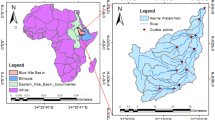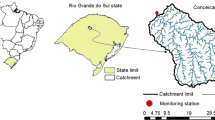Abstract
Purpose
Soil erosion is one of the most significant environmental problems in the Ethiopian highlands. The study was conducted in the main Gumara-Maksegnit watershed and at the sub-catchment scale with and without soil and water conservation (SWC) measures to estimate event-based sediment yield and evaluate the effectiveness of level stone bunds on sediment reduction.
Materials and methods
The runoff volume and peak discharge were recorded manually with the help of a time series of pictures using the DOERR digital camera. The sediment concentration was determined from manual runoff samples and grid-based soil samples were collected at 162 points. The slope map and satellite image were obtained from the USGS Earth Explorer database with 30-m and 15-m spatial resolutions, respectively. Finally, all six-model factors were combined using the raster calculator in map algebra through the MUSLE framework. The paired t test parametric procedures were applied to test whether the means of event-based predicted and observed sediment yield values are different.
Result and discussion
The average event-based observed and estimated sediment yields were 0.5581 and 0.4031 Mg ha−1 for the Gumara-Maksegnit watershed, 0.5125 and 0.4194 Mg ha−1 for the treated (with SWC) sub-catchment, and 1.0694 and 1.0150 Mg ha−1 for the untreated (without SWC) sub-catchment, respectively. The observed and estimated sediment losses within the main watershed and sub-catchments were not significantly different. However, comparing the treated and untreated sub-catchments, the sediment losses were highly significantly different and the stone bunds have a capacity for reducing sediment loss by 58.8%. In general, the MUSLE model performed well to estimate sediment yield in the study area with R2 values of 0.62, 0.72, and 0.7 and NSE values of 0.53, 0.71, and 0.34 for treated, untreated, and the main Gumara-Maksegnit watershed, respectively.
Conclusion
The results showed that stone bunds have a capacity for reducing sediment loss by 58.8% as compared with untreated sub-catchment. Therefore, successful implementation of stone bunds in the study area, as well as similar agro-ecologies, has a great benefit to enhance land productivity. Meanwhile, the MUSLE model was well suited for reliable applications of sediment yield estimation in the study area.







Similar content being viewed by others
References
Addis HK, Klik A (2015) Predicting the spatial distribution of soil erodibility factor using USLE nomograph in an agricultural watershed, Ethiopia. Soil Water Conserv Res 3(4):282–290
Addis HK, Strohmeier S, Ziadat F, Melaku ND, Klik A (2016) Modeling streamflow and sediment using SWAT in Ethiopian highlands. J Agr Biol Eng 9(5):51–66
Alemu WG, Amare T, Yitaferu B, Selassie YG, Wolfgramm B, Hurni H (2013) Impacts of soil and water conservation on land suitability to crops: the case of Anjeni watershed, Northwest Ethiopia. J Agr Sci 5(2):95–109
Arekhi S (2008) Evaluating long-term annual sediment yield estimating potential of GIS interfaced MUSLE model on two micro-watersheds. Pak J Biol Sci 11:270–274
Ashish P, Chowdary VM, Mal BC (2009) Sediment yield modeling of an agricultural watershed using MUSLE, remote sensing and GIS. Paddy Water Environ 7:105–113
Birhanu A (2014) Environmental degradation and management in Ethiopian highlands: review of lessons learned. J Environ Protect Policy 2(1):24–34
Bos MG (1976) Discharge measurement structures. ILRI Publ 20, International Institute for Land Reclamation and Improvement, Wageningen, the Netherlands
Daniel EB, Camp JV, LeBoeuf EJ, Penrod JR, Dobbins JP, Abkowitz MD (2011) Watershed modeling and its applications: a state-of-the-art review. Open Hydrol J 5:26–50
Desta G, Poesen J, Nyssen J, Deckers J, Haile M, Govers G, Moeyersons J (2005) Effectiveness of stone bunds in controlling soil erosion on cropland in the Tigray highlands, northern Ethiopia. Soil Use Manag 21:287–297
Efthimiou N, Lykoudi E, Karavitis C (2014) Soil erosion assessment using the RUSLE model and GIS. European Water 47:15–30
Foster GR, McCool DK, Renard KG, Moldenhauer WC (1981) Conversion of the universal soil loss equation to SI metric units. J Soil Water Conserv 36(6):355–359
Gizaw D, Kebede M (2019) Spatial and temporal distribution of sediment yield-case study Nashe, Blue Nile Basin, Ethiopia. JWS 9(2):23–34
Guzman C, Tilahun S, Zegeye A, Steenhuis T (2013) Suspended sediment concentration--discharge relationships in the (sub-) humid Ethiopian highlands. Hydrol Earth Syst Sci 17(3):1067–1077
Habtamu M, Melesse T, Fantaw Y (2013) Soil loss prediction using USLE and MUSLE under conservation tillage integrated with ‘fanya juus’ in Choke Mountain, Ethiopia. J Agr Sci 3(10):46–52
Haregeweyn N, Tsunekawa A, Nyssen J, Poesen J, Tsubo M, Tsegaye Meshesha D, Tegegne F (2015) Soil erosion and conservation in Ethiopia: a review. Prog Phys Geogr 39(6):750–774
Hurni H (1985) Erosion-productivity-conservation systems in Ethiopia. Paper presented at the proceedings 4th international conference on soil conservation, Maracay, Venezuela, 3-9 November 1985:654-674
Hurni H, Berhe WA, Chadhokar P, Daniel D, Gete Z, Grunder M, Kassaye G (2016) Soil and water conservation in Ethiopia: guidelines for development agents Bern, Switzerland, Centre for Development and Environment (CDE): University of Bern, with Bern Open Publishing (BOP)
Jaramillo F (2007) Estimating and modeling soil loss and sediment yield in the Maracas-St. Joseph River catchment with empirical models (RUSLE and MUSLE) and a physically based model (Erosion 3D). (MSc), McGill University, Montreal, Canada
Kassie M, Pender J, Yesuf M, Kohlin G, Bluffstone R, Mulugeta E (2007) Impact of soil conservation on crop production in the northern Ethiopian highlands. IFPRI Discussion Paper, 00733
Kinnell PIA (2005) Why the universal soil loss equation and the revised version of it do not predict event erosion well. Hydrol Process 19:851–854
Klik A, Strohmeier S, Schürz C, Brenner C, Zehetbauer I, Kluibenschädl F, Ziadat F (2015) Monitoring of surface run-off and soil erosion processes. In: Ziadat F, Bayu W (eds) Mitigating land degradation and improving livelihoods. Routledge, New York, USA, pp 145–170
Kumar PS, Praveen T, Prasad MA (2015) Simulation of sediment yield over un-gauged stations using MUSLE and fuzzy model. Aquatic Procedia 4:1291–1298
Lakew D (2000) Land degradation and strategies for sustainable development in the Ethiopian highlands: Amhara region (Vol. 32): ILRI (aka ILCA and ILRAD)
Moore ID, Burch GJ (1986) Modeling erosion and deposition: topographic effects. Trans ASAE 26:1624–1630
NASA (2017) Landsat ETM+ Scene LC 08 170/051 2017 056 LGN03_LC 08_L1 TP_170 051_2017 02 25_2017 03 01_01_T1 USGS, 2017-03-01. http://dds.cr.usgs.gov
Nigussie Z, Tsunekawa A, Haregeweyn N, Adgo E, Nohmi M, Tsubo M, Abele S (2017) Farmers’ perception about soil erosion in Ethiopia. Land Degrad Dev 28(2):401–411
Odongo VO, Onyando JO, Mutua BM, Oel PR, Becht R (2013) Sensitivity analysis and calibration of the Modified Universal Soil Loss Equation (MUSLE) for the upper Malewa catchment, Kenya. J Sediment Res 28:368–383
Pongsai S, Schmidt Vogt D, Shrestha RP, Clemente RS, Eiumnoh A (2010) Calibration and validation of the modified universal soil loss equation for estimating sediment yield on sloping plots: a case study in Khun Satan catchment of northern Thailand. Can J Soil Sci 90(4):585–596
Remortel VR, Hamilton M, Hickey R (2001) Estimating the LS factor for RUSLE through iterative slope length processing of digital elevation data. Cartography 30(1):27–35
Rieder J, Strohmeier S, Demelash N, Ziadat F, Klik A (2014) Investigation of the impact of stone bunds on water erosion in northern Ethiopia. Paper presented at the EGU General Assembly Conference Abstracts
Sadeghi SHR (2004) Application of MUSLE in prediction of sediment yield in Iranian conditions. Paper presented at the ISCO2004-13th ISCO conference, July 2004, Brisbane, Australia
Sadeghi SH, Mizuyama T, Vangah BG (2007) Conformity of MUSLE estimates and erosion plot data for storm-wise sediment yield estimation. TAO: Terr Atmos Ocean Sci 18(1):117–128
Sadeghi SHR, Mizuyama T (2007) Applicability of the modified universal soil loss equation for prediction of sediment yield in Khanmirza watershed, Iran. Hydrol Sci J 52(5):1068–1075
Sadeghi SHR, Gholami L, Khaledi Darvishan A, Saeidi P (2014) A review of the application of the MUSLE model worldwide. Hydrolog Sci J 59(2):365–375
Strohmeier S, Rieder J, Kaltenleithner M, Demelash N, Guzmán G, Ziadat F, Klik A (2015) Using magnetite tracer to evaluate a novel plot experimental design for the assessment of soil and water conservation impacts of stone bunds in Ethiopia. Paper presented at the EGU General Assembly Conference Abstracts
Williams, Berndt (1977) Sediment yield prediction based on watershed hydrology. Trans Am Soc Agric Eng 20(6):1100–1104
Wischmeier WH, Johnson CB, Cross BV (1971) Soil erodibility nomograph for farmland and construction sites. Soil Water Conserv J 26(5):189–193
Wischmeier WH, Smith DD (1978) Predicting rainfall erosion losses: a guide to conservation planning. Beltsville, Maryland U.S. Department of Agriculture, Agriculture Handbook No. 537
Wolka K, Moges A, Yimer F (2011) Effects of level soil bunds and stone bunds on soil properties and its implications for crop production: the case of Bokole watershed, Dawuro zone, southern Ethiopia. Agr Sci 2(03):357–363
Zehetbauer I, Strohmeier S, Ziadat F, Klik A (2013) Runoff and sediment monitoring in an agricultural watershed in the Ethiopian highlands. Paper presented at the EGU General Assembly Conference Abstracts
Acknowledgments
The authors are very grateful to the International Center for Agricultural Research in Dry Areas (ICARDA) for the establishment of the research facility in the study area and financial support to collect the data. Furthermore, the authors would like to thank the Amhara Regional Agricultural Research Institute (ARARI) for their financial support.
Author information
Authors and Affiliations
Corresponding author
Ethics declarations
Conflict of interest
The authors declare that they have no conflict of interest.
Additional information
Responsible editor: Jan Schwarzbauer
Publisher’s note
Springer Nature remains neutral with regard to jurisdictional claims in published maps and institutional affiliations.
Rights and permissions
About this article
Cite this article
Alemayehu, A.A., Muluneh, A., Moges, A. et al. Estimation of sediment yield and effectiveness of level stone bunds to reduce sediment loss in the Gumara-Maksegnit watershed, Nile Basin, Ethiopia. J Soils Sediments 20, 3756–3768 (2020). https://doi.org/10.1007/s11368-020-02715-y
Received:
Accepted:
Published:
Issue Date:
DOI: https://doi.org/10.1007/s11368-020-02715-y




